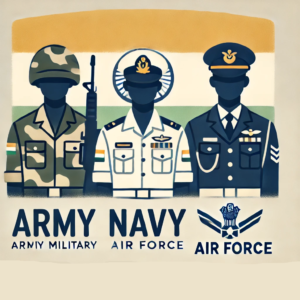Indian Military Ranks and Structure – Explained
The Indian military, one of the largest and most powerful forces globally, consists of three main branches: the Army, the Navy, and the Air Force. Each branch has its own rank system, which plays a crucial role in organizing personnel and defining responsibilities.

Indian Army Ranks and Structure
Officers in the Indian Army
- Field Marshal
The highest rank, awarded only in extraordinary cases. - General
The top active rank, responsible for overall military strategy as the Chief of Army Staff (COAS). - Lieutenant General
In charge of large formations and divisions in the Army. - Major General
Typically oversees a division of around 10,000 soldiers and reports to a Lieutenant General. - Brigadier
Leads a brigade, a unit smaller than a division. - Colonel
Commands a regiment or battalion, with significant leadership responsibilities. - Lieutenant Colonel
Often commands a battalion and handles operations and administration. - Major
Serves as second-in-command of a battalion or regiment, focusing on planning and operations. - Captain
Typically in charge of a company, directly leading soldiers during operations. - Lieutenant
The entry-level rank for officers, typically leading a platoon or company.
Other Ranks in the Indian Army
- Subedar Major
The highest non-commissioned officer, assisting with administrative and leadership tasks at higher levels. - Subedar
Oversees troops and acts as a link between officers and other ranks. - Naib Subedar
A junior officer rank, similar to a Sergeant, assisting with leadership and supervision. - Havildar
A senior non-commissioned officer who leads a squad and provides guidance. - Naik
Supervises a small group of soldiers, ensuring smooth operations. - Lance Naik
The lowest rank among non-commissioned officers, responsible for specific duties. - Sepoy
The basic soldier rank, performing a variety of operational duties.
Indian Navy Ranks and Structure
Officers in the Indian Navy
- Admiral
The highest rank, responsible for all naval operations and strategy. - Vice Admiral
Manages large sections or fleets within the Navy. - Rear Admiral
In charge of strategic management of specific naval groups or regions. - Commodore
Leads a flotilla or similar naval unit. - Captain
Commands a ship and is responsible for its operations and crew. - Commander
Leads smaller ships or submarines, or specific units within the Navy. - Lieutenant Commander
Helps manage specific operations or smaller sections of the Navy. - Lieutenant
In charge of a division or unit aboard a ship or submarine. - Sub Lieutenant
An entry-level officer working in various operational and leadership roles.
Other Ranks in the Indian Navy
- Master Chief Petty Officer
The highest rank among sailors, overseeing operations and crew management. - Petty Officer
Supervises lower-ranking sailors and helps manage shipboard activities. - Leading Seaman
In charge of smaller groups of sailors, assisting with operations and training. - Seaman
The basic rank, handling tasks related to maintaining and operating ships.
Indian Air Force Ranks and Structure
Officers in the Indian Air Force
- Marshal of the Air Force
The highest possible rank, awarded for extraordinary service. - Air Chief Marshal
The head of the Air Force, overseeing its entire operations. - Air Marshal
In charge of major Air Force regions or branches. - Air Vice Marshal
A high-ranking officer in charge of specific air commands. - Air Commodore
Leads units, often managing wings or groups. - Group Captain
Oversees groups of squadrons, ensuring operational success. - Wing Commander
Leads a squadron and manages air operations. - Squadron Leader
Responsible for managing aircrews, maintenance, and missions. - Flight Lieutenant
Involved in flying operations, supporting leadership in air missions. - Flying Officer
A junior officer responsible for flying duties under senior officers.
Other Ranks in the Indian Air Force
- Warrant Officer
A senior non-commissioned officer in charge of larger teams and responsibilities. - Junior Warrant Officer
A lower non-commissioned officer rank, assisting in managing smaller groups. - Sergeant
Responsible for ensuring smooth daily operations, training airmen, and maintaining discipline. - Leading Aircraftman
A junior officer assisting in Air Force operations. - Aircraftman
The basic rank, performing various support and operational roles.
Summary
The Indian military comprises three branches: the Army, Navy, and Air Force, each with its own hierarchical ranking system. The structure ensures efficient operations, discipline, and leadership, with officers managing military strategies and Other Ranks performing essential support tasks. The highest-ranking officers, such as the General (Army), Admiral (Navy), and Air Chief Marshal (Air Force), are responsible for overseeing major operations and strategic decisions.
Tags: Admiral, Air Chief Marshal, Air Commodore, Air Force officers, Air Marshal, Air Vice Marshal, Aircraftman, Army officers, Brigadier, Captain, Colonel, Commander, Commodore, defense forces, Field Marshal, Flight Lieutenant, Flying Officer, General, Group Captain, Havildar, Indian Air Force ranks, Indian Army ranks, Indian military, Indian Navy ranks, Junior Warrant Officer, Lance Naik, Leading Aircraftman, Leading Seaman, Lieutenant, Lieutenant Colonel, Lieutenant Commander, Lieutenant General, Major, Major General, Marshal of the Air Force, Master Chief Petty Officer, military hierarchy, military leadership, military organization, military ranks, military roles, military structure, Naib Subedar, Naik, Navy officers, non-commissioned officers, operational command., Petty Officer, Rear Admiral, Seaman, Sepoy, Sergeant, Squadron Leader, Sub Lieutenant, Subedar, Subedar Major, Vice Admiral, Warrant Officer, Wing Commander


